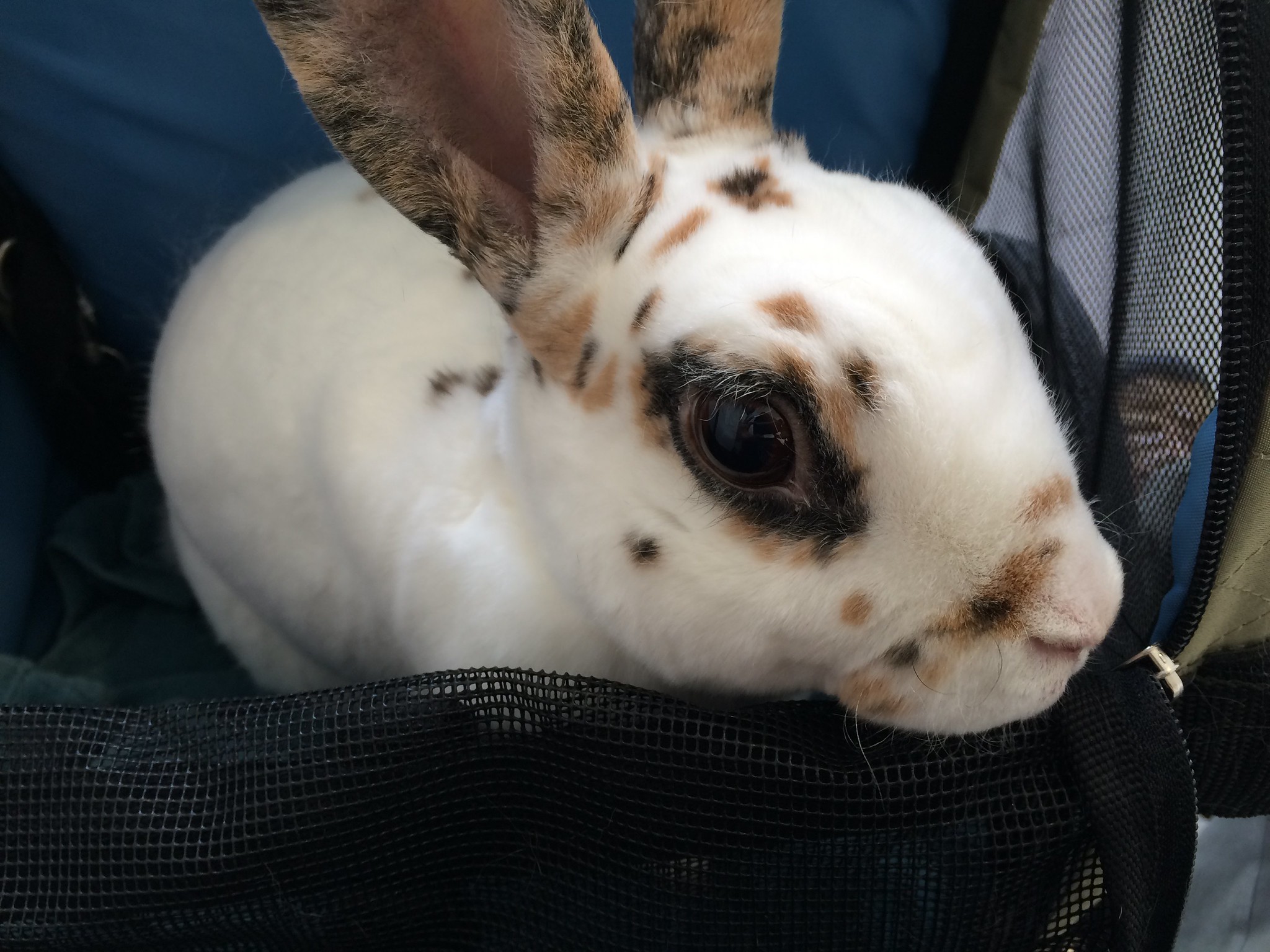
We need to leave for our vet appointment in less than ten minutes.
I’ve scooped up Monty, my furry white whale of a boy. It was easy only because he’d been asleep. Monty’s theme song? “Don’t Fence Me In.” He’s scaled thirty-six inch exercise pens. As I load him in the crate, he clearly disapproves. I manage to safely tuck his nose inside before hurriedly latching the door.
Now it’s Pixel’s turn. But my delicate diva of a daintily dappled Rex has been alerted by the flurry of Monty’s capture. She knows something’s up and wants none of it.
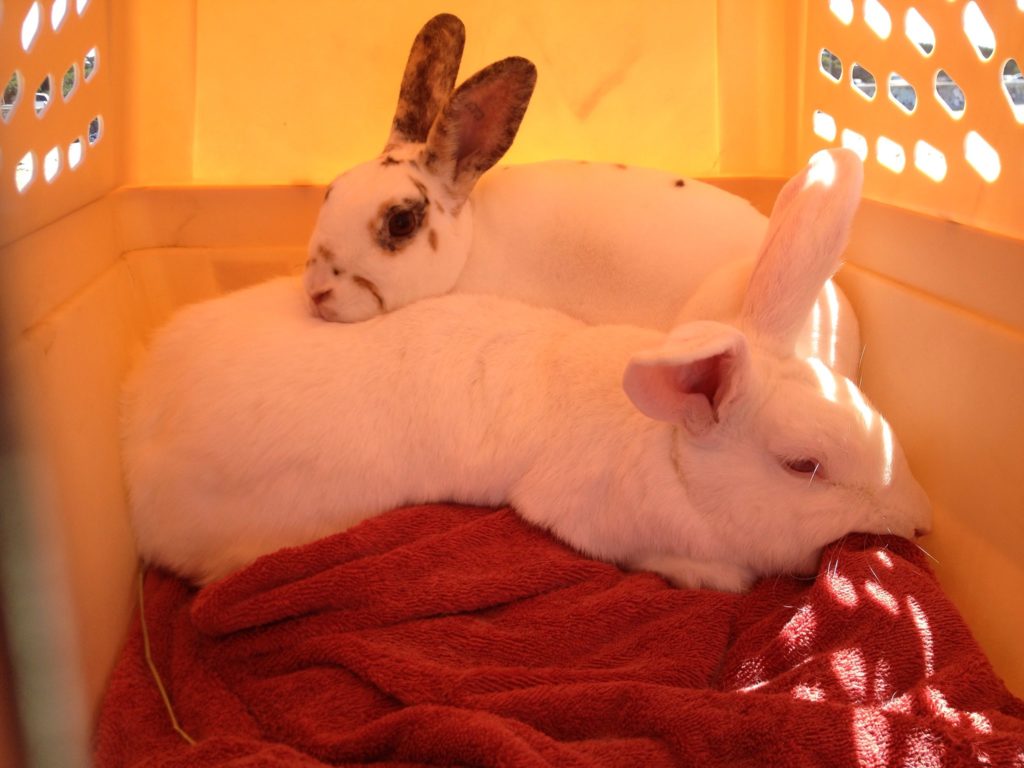
I approach casually, cooing in my most dulcet tones. “How’s my sweet girl?” She eyes me warily. I slowly start to crouch and…. Woosh! We’re off to the cartoon races. Her soft spotted coat’s a blur as her furry feet launch her into full-fledged flight.
Chaos ensues as her various hiding places are snatched from the floor and hastily stashed out of reach. My husband David tries to unfold an x-pen to corral her, while I’m pulling out chairs and commando crawling under the dining table to flush Pixel from her last refuge.
She’s in full wily wabbit mode: Adept as a prey animal should be at avoiding capture. By the time we finally manage to snare and deposit her in the crate — with Monty still doing his best to slip back out — we’re all disheveled, hard-breathing wrecks.
For the rabbits, the car ride and vet visit will be scary enough. What a miserable way to start!
But that brand of bunny bedlam is now relegated to years past. These days, things are very different when rabbit road trips are required: Our bunnies are crate trained.
What’s Crate Training?
I talked at length about crate training in my last post, but the short answer is it’s training your rabbit to go into the crate willingly and happily. If the scene described above sounds familiar, this will be a game-changer for you, too.
So if you’re interested, I’ll tell you how to make it happen.
When to Begin
Most people, myself included, will procrastinate on this until about 3 days before you need to take your rabbit somewhere. Unless you are a highly skilled animal trainer, that’s not going to be enough time. It’s better to plan well ahead. Start when you have no reason to travel for at least a month. If you do have a known trip coming up soon, wait and start your training after that excursion is over.
Also, before you proceed further, I recommend you
- read my Road Rabbits post
- prepare your training skills and a suitable crate
- do some habituation to the crate as described in the Road Rabbits article,
Once you’re ready to get started on this, put the crate away and only get it out when you’re using it for training.
Step 1: Move Towards the Crate
Start your training session by loading the crate with food, and putting it out on the floor with the door open.
Try using a recall command for your rabbit when you are near the crate. That is, stand near the crate and call her over.
If your bun is reluctant to go near the crate, I recommend you stop crate training for a while, and instead teach your rabbit to touch a target with her nose . Once she has the hang of this and enjoys doing it, you’ll be able to use the target stick to move her closer to the carrier in the early stages of crate training. Make sure you have target training to the point where your rabbit consistently comes to the target without hesitation before you go back to crate training.
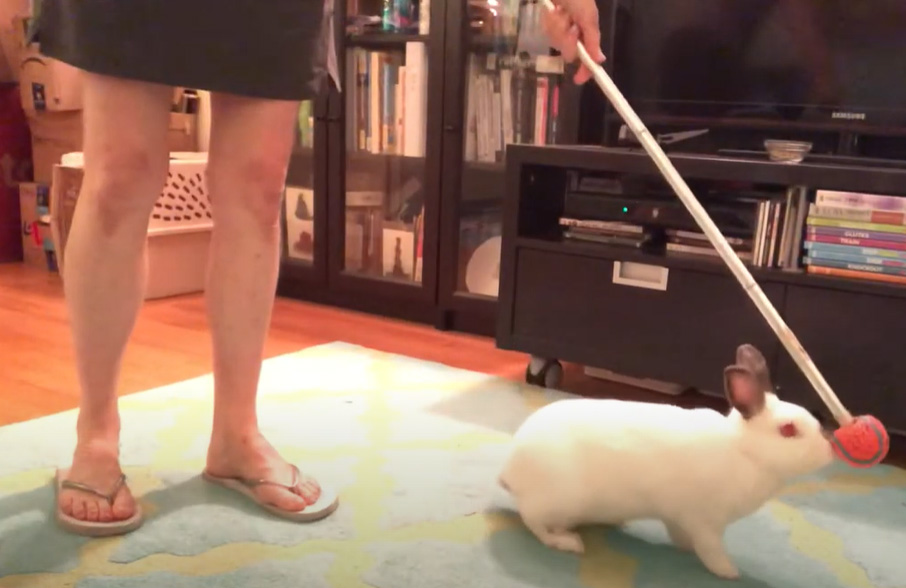
At that point, you can start targeting her near the crate. If you move the target closer to the crate and she’s hesitating to go to it, you’re asking for too much. Go back to a place you know she’s comfortable with. Let her get some rewards for targeting in her safe zone and then move towards the crate in smaller increments than before.
Remember to keep training fun. If it starts getting scary, your pupil isn’t going to want to play this game any more! Be patient. She will get there eventually, even if you have to move a millimeter at a time.
As always, keep your training sessions short. Five minutes at a time is plenty.
Step 2: Go Inside with the Door Open
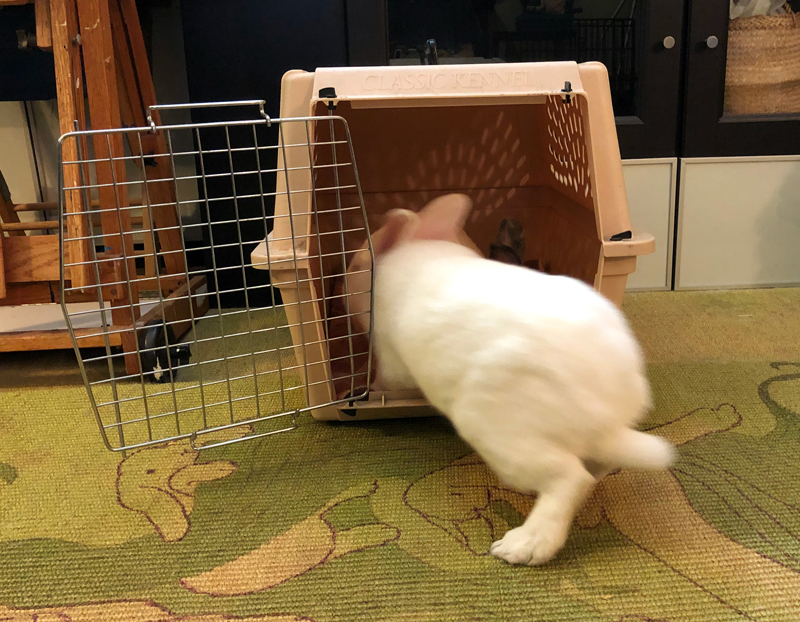
If/when you’re able to get your rabbit close to the open crate, the next step is going inside. For a target trained rabbit you can put the target stick just inside the crate to lure her in, if you can do so without blocking her way,
Otherwise, just have the front of the crate loaded with a fragrant treat so she’ll smell it a few inches away. Some rabbit cereals have strong aromas. Herbs like basil or mint will often do the trick as well. Make sure to put most or all the food just inside the open door, so she doesn’t actually have to get inside to eat it. At first, just getting her nose into the doorway of the crate is good enough.
Once she’s comfortable sticking her head in and expects there to be treats inside the crate, continue putting treats in easy reach, but start also putting some further back and see if she’ll put a paw in to get them. When that gets comfortable, make it two paws, and so on.
Getting the back paws in is the toughest, because this constitutes a commitment. For a rabbit, backing up is about as graceful and effortless as me stepping over a 30″ pet gate. It’s neither quick nor easy, and she knows this. Being unable to quickly escape makes bunnies nervous! So take it slow, inch by inch, until you get those back paws inside without hesitation. Soon you will be able to set the open crate down and she’ll hop right in and go all the way to the back to eat her treats.
Step 3: Closing the Door
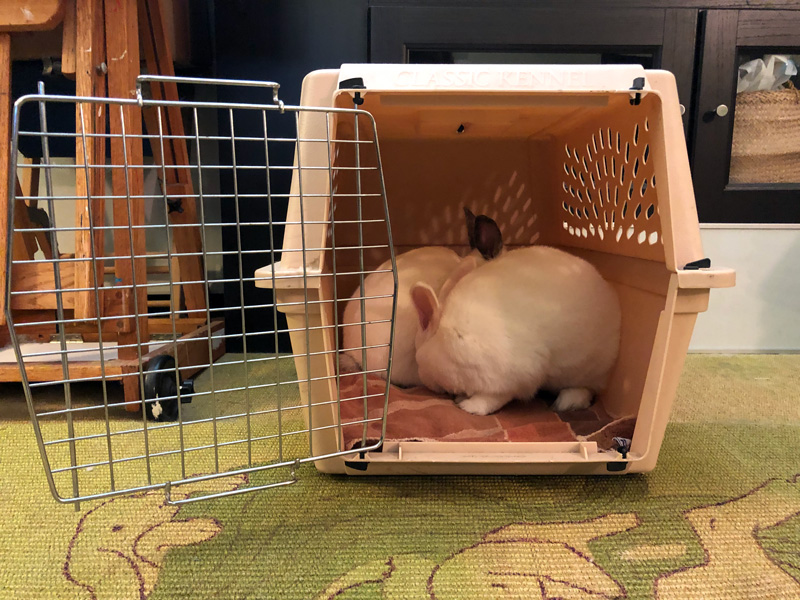
Being in the crate with the door closed is another big milestone for a rabbit. Bolder bunnies, like Moraea, might be too busy snarfing their treats to be bothered by the door closing, whereas a sensitive guy like Finnegan always has one ear listening for any hint of a closing portal. He’ll whip around and give me the stink eye the second I move that thing. So this is another area where you have to take it at your bunny’s pace.
You can try just touching the door. Then move it an inch and swing it right back open. Increase the amount you close it bit by bit.
If the bunny shows any sign of alarm or wariness, you have gone too fast. Having too many nervous feelings arise while inside the crate could negate all the great progress you made getting him to enter. Advance slowly enough that your bun doesn’t notice. Eventually you’ll be able to close it for a millisecond and swing it open immediately. After that, you can gradually increase the duration until it’s as long as you like.
High-value treats like fruit or bunny cookies can be great to get a behavior started, but you have to limit how much of those you hand out. For duration, you’ll need to use a lower-value treat, something he can munch on for a while. This is where I think it comes in really handy to use my bunnies’ daily pellet (cereal) ration as their training treats. I can just put “dinner” in the back of the travel carrier.
If you want, you can continue this training through a bunch more steps – closing the door and then moving the crate a tiny bit, then a little more, and more, until ultimately you can pick it up and carry your precious cargo around the room without upsetting her. For many bunnies, the sensation of the carrier moving is a big bummer, so this part can be pretty challenging, and could take a long time. If your goal is just to be able to load your rabbit into a travel crate for an occasional relocation or vet visit, I don’t think it’s really necessary.
Maintaining This Behavior
In animal trainer terms, behavior will “go on extinction” — be lost — if it stops being reinforced. Once you’ve got it down, practice your crate training regularly, so it’s always ready when you need it. About once a month, at least.
Also, if the only time you ever ask your bunny to get in the crate is when you’re about to go somewhere with her, it may become something she associates with bad outcomes (like car rides). You should practice at least five times for every time you actually have to travel. A ratio of five-to-one or greater will keep her feeling like going into the crate is more likely to be fun than scary.
Here’s Finnegan and Moraea having a little refresher session. While I can close the door, you can see in the video that Finnegan is still not 100% at ease with it and could use more practice. Moraea, on the other hand, seems blissfully unaware of the state of the door.
 The Fluffy Tail of This Blog Post
The Fluffy Tail of This Blog Post
Crate training can be accomplished pretty easily. if you’re patient you can make it fun for your bun and complete it step by step. It really pays back your effort by simplifying the task of preparing to travel with your rabbit. I hope you’ll give it a try!
Lita says:
This is fantastic thank you for writing this.
Melinda says:
Thanks, Lita! Please let me know if you try this and how it works out for you.